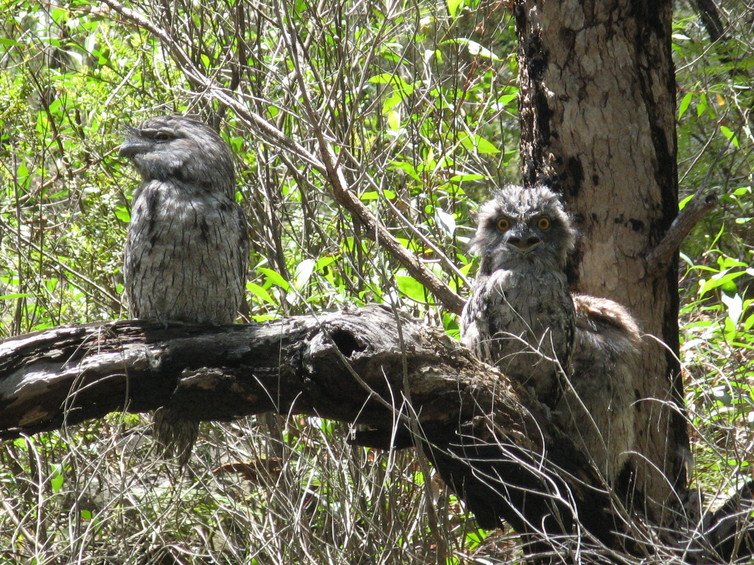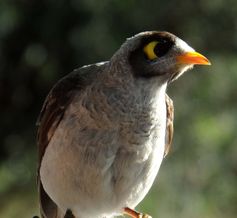Laughs, cries and deception: birds’ emotional lives are just as complicated as ours

JULY ON THE Northern Tableland, near Armidale in New South Wales, is usually the beginning of the breeding season and field observations start early.
I sat and watched in freezing temperatures. The sun was just rising above the horizon of this 1000m-high plateau when through binoculars I saw a young lone magpie, walking gingerly, literally tip-toeing, occasionally interrupted by little bouts of running and, unusually, heading straight for its territorial boundary.
In the last stretch to the border, the bird edged along a row of pine trees, staying low, and kept looking over its shoulder, especially when crossing the neighbour’s border. Shortly afterwards, a female was seen in his company.
Later, the male backtracked and, when far enough into his own territory, started foraging rather aimlessly as if nothing had happened.
The magpie who snuck over the border. (Source: Gisela Kaplan)
What had I witnessed? Did this young male magpie understand that he was breaking several important magpie social rules and could face punishment for this transgression if caught? Did he have a sense of morality?
Science has traditionally shunned the idea of emotions in animals, not just for fear of anthropomorphism or over-interpretation, but also because there is a very long cultural history that played out a divide between mind and body and reason and emotions.
Reason, thinking and making judgements were stubbornly thought to be outside the capacity of animals. For a long time it was not believed that animals were even capable of feeling pain, let alone complex emotions. We now know that is far from the truth.
Birds with feelings
Pet owners have always known that their pets can be affectionate, sulky, jealous, sad, excited and deliberately naughty, as well as doing extraordinary things for their owners. The animals we know best in this regard are obviously dogs and cats.
Charles Darwin was the first to discuss emotions in animals in the mid-19th century. A century later, Niko Tinbergen addressed the vexing question of emotions.
Following on from Darwin, he identified “four Fs” as part of survival: fight, flee, fornicate and feed. These translate into basic feelings of fear, hunger and sexual drive – now called motivational states.
Tawny frogmouths are monogamous. (Source: cskk/Flickr, CC BY-NC-ND)
But there is a lot more to bird emotions. Dangerous and horrible experiences are usually remembered. Memory helps survival. Modern urban birds have been shown to remember faces of people considered dangerous and threatening.
We now know that the bird brain is lateralised (each side of the brain controls a different set of functions) as in humans and other vertebrates. The right hemisphere expresses intense emotions (such as fear and attack). The left hemisphere has routine, considered responses and may inhibit some of the strong responses of the right hemisphere.
So birds are more similar to humans than had ever been thought, but with an important difference: birds are generally not aggressive without cause. Technically, aggression is an emotion that is dysfunctional, has no purpose and often even harms the individual displaying it.
Birds can certainly get very angry – and the owner of a galah or corella would be well advised not to get near this bird when the head feathers are raised — but birds can be joyful and playful, can get depressed and, as studies have shown, a neglectful or bare environment can even make them pessimistic.
Birds may feel for others (have empathy) and even console them, may have a sense of justice, may show deep affection for their partner and grieve for their loss. I witnessed the mate of a fatally injured tawny frogmouth not moving from the spot next to its dead partner for three days, and then dying on the fourth.
Social smarts
Australian native birds have an unusually high percentage of pair-bonding (over 90% of species) and the highest concentrations of cooperative species (relatives or siblings helping at the nest) anywhere in the world. Cockatoos bonding for life often have intense close partnerships, which are nurtured by constant grooming and attention to each other’s needs.
Such intense cohabitation of individuals, often for many years (how about 60 years of “marriage” in sulphur-crested cockatoos?), may also create frictions and dissatisfactions that require solutions to keep the pair or group together.
For instance, the lazy helper at the nest who only pretends to help in feeding, as happens among white-winged choughs, may get scolded by an adult. A group of apostlebirds building a mud nest together, transporting mud to the nest in relays, may spot an individual that is not pulling its weight.
Apostlebirds breed in families, and all are expected to pull their weight. (Source: Gisela Kaplan, Author provided)
I have witnessed on several occasions near Copeton Dam (in Inverell, NSW) apostlebirds become so outraged that they approach the individual with heightened calling and may even peck it until the intimidated individual falls back into line and does its share.
Empathy, altruism and consoling the injured or vanquished have all been observed in birds, thought to be the ultimate in consideration for another individual’s state of mind.
For instance, there are observations of dusky wood-swallows (belonging to the same family of birds as butcherbirds and magpies) in Western Australia’s Wheatbelt hassling a restless flycatcher with a larva in his beak, perched on a branch. One wood-swallow flew above the flycatcher, while the other simultaneously flew directly at it, snatched the larva from its beak while it was distracted by the other bird hovering overhead, and took it away. So who got the prize?
If all behaviour in animals is selfish, then the one who caught it should have gulped it down, but it did not. It gave it to the bird that had distracted the flycatcher. Perhaps the two birds reversed roles in the next, similar, situation. But it still meant overcoming the temptation to eat.
The noisy miner who defended a puppy. (Source: Gisela Kaplan, Author provided)
A noisy miner, one of the cooperative honeyeaters, I had hand-raised grew up over several weeks in the company of very young ridgeback pups near the edge of a nature reserve in a NSW coastal area.
One pup was sleeping on the porch in the sun and I was some distance away. I was alerted by the alarm calls of the noisy miner and turned around to see it swooping right down to a lace monitor’s head – doing so over and over again. I ran as quickly as I could, by now also shouting once the risk to the pup was more than apparent.
When the monitor spotted me, it turned and fled. The noisy minor had risked its life to save the pup. At no other occasion did the bird attempt to swoop a lace monitor. Its response was very specific to this situation.
And, as I have been asked often, could birds have a sense of humour? Perhaps.
Our galah, Philip, deeply affectionate (and jealous!) had learned the names of all our dogs and was such a good mimic of our voices that he could easily and effectively call the dogs to attention.
Imagine the picture: a bird less than a foot tall, standing on the floor and calling four massive Rhodesian ridgebacks to attention. Then, when he got them all in line in front of him, he walked away, swaying his head and even making little chuckling sounds.
The degree to which emotions and complex feelings for others were developed may well depend on social organisation. It may be that birds with long-term social bonds show more complex behaviour and brains than those whose associations are only fleeting.
What they get out of it is perhaps not debatable — more joy, more grief, but also a greater degree of safety and usually a longer life. There are clear benefits of sticking together in a difficult and fickle continent.
Gisela Kaplan is a Professor of Animal Behaviour at the University of New England, NSW>
This article was originally published on The Conversation. Read the original article.





